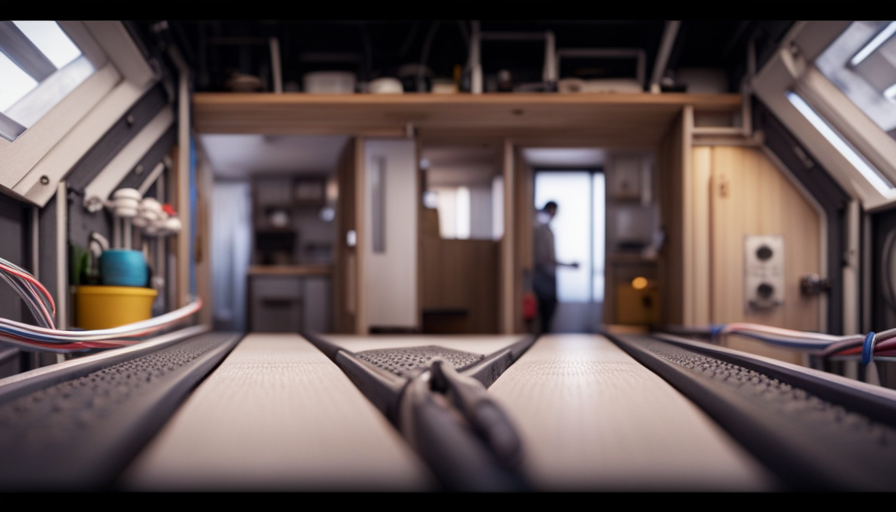Get ready for an incredible revelation! The compact home industry is growing at a speed faster than a supernova!
Okay, maybe not that fast, but trust me when I say it’s a force to be reckoned with. As a passionate advocate for all things tiny house, I’ve witnessed firsthand the meteoric rise of this industry.
In this article, we’re going to delve deep into the data, uncovering just how big the tiny house movement has become. From its astonishing growth to its economic impact, we’ll explore the reasons behind its popularity and the benefits of embracing a minimalist lifestyle.
But it’s not all sunshine and rainbows; we’ll also address the challenges and considerations that come with living in a tiny house.
Get ready to be enlightened, because the tiny house revolution is here to stay.
Key Takeaways
- The tiny house industry is experiencing rapid growth, projected to reach $5.7 billion by 2027.
- Tiny houses offer affordable housing options and reduce environmental footprint, aligning with the growing demand for sustainable and minimalist living.
- The industry has created thousands of new jobs in construction, manufacturing, tourism, and related sectors.
- Tiny house festivals and gatherings provide networking and support within the community, showcasing the latest design trends and sustainability in construction.
Growth of the Tiny House Industry
The tiny house industry has been experiencing rapid growth, with more and more people opting for compact living spaces. This trend can be attributed to several factors, including economic growth and market demand.
As the economy has improved, individuals are seeking affordable housing options that allow them to save money and reduce their environmental footprint. Additionally, there is a growing desire for simplicity and minimalism, with many people realizing that they don’t need a large, traditional home to be happy and comfortable. This shift in mindset has led to an increased interest in tiny houses, driving the industry’s expansion.
Market demand has played a significant role in the growth of the tiny house industry. People are increasingly drawn to the idea of downsizing and living a more sustainable lifestyle. Tiny houses offer a solution to rising housing costs and provide an opportunity for individuals to live mortgage-free. They also offer the flexibility to move and travel more easily, which appeals to those seeking a sense of freedom and adventure. As a result, the market for tiny houses has expanded rapidly, with more companies and builders entering the industry to meet the growing demand.
The economic impact of the tiny house movement has been substantial. It has created jobs in the construction and manufacturing sectors, as well as in related industries such as design, consulting, and real estate. Additionally, the increased interest in tiny houses has led to the development of new products and services tailored to this market. From specialized furniture to innovative storage solutions, entrepreneurs have capitalized on the demand for tiny house living.
Overall, the growth of the tiny house industry has had a positive economic impact, providing opportunities for both businesses and individuals alike.
Economic Impact of the Tiny House Movement
The economic impact of the Tiny House movement is significant and can be seen in multiple ways.
Firstly, the revenue generated by the Tiny House industry is substantial, with estimates suggesting that it’s a multi-billion dollar industry.
Secondly, the construction of Tiny Houses has created numerous job opportunities in the construction sector, providing employment for skilled workers and supporting local economies.
Lastly, the rise in Tiny House tourism has also contributed to the economic boost in various regions, as visitors spend money on accommodations, dining, and local attractions, further stimulating the local economy.
Revenue generated by the Tiny House industry
With a surge in popularity, the tiny house industry has managed to generate substantial revenue, creating a financial landscape as vast as the open road. Revenue growth in the tiny house sector has been impressive in recent years, reflecting the increasing demand for these compact, affordable homes.
According to a report by Research and Markets, the global tiny house market size is projected to reach $5.7 billion by 2027, growing at a CAGR of 7.6% from 2020 to 2027. This growth can be attributed to factors such as rising housing costs, environmental concerns, and the desire for a simpler lifestyle.
As the industry continues to expand, it is expected to create even more job opportunities in the tiny house construction sector. Transitioning to the subsequent section, job creation in this field is just one of the many positive outcomes of the thriving tiny house industry.
Job creation in the Tiny House construction sector
Looking to join a booming sector? The construction of tiny homes offers exciting job opportunities and a chance to be part of a thriving industry. The job growth in the tiny house construction sector has been remarkable, with more and more people opting for these compact and sustainable living spaces.
According to a report by the National Association of Home Builders, the tiny house industry has created thousands of new jobs across the country. This growth in employment has not only had a positive impact on the individuals working in the industry, but it has also contributed to the overall economic growth of local communities.
With the rising demand for tiny homes, the construction sector is expected to continue expanding, providing even more job opportunities in the future. This job creation, coupled with the economic impact of the tiny house industry, has brought about a boost to local economies.
As we delve into the next section about the boost to local economies through tiny house tourism, we will see how these small homes are not only changing the way people live but also transforming communities.
Boost to local economies through Tiny House tourism
Imagine being part of the thriving tiny house tourism industry, where you can contribute to the economic growth of local communities and create unforgettable experiences for travelers. Tiny house tourism has become increasingly popular in recent years, offering a unique and sustainable way for individuals to explore new places. Here are five reasons why tiny house tourism is contributing to a boost in local economies:
-
Increased tourism revenue: Tiny house rentals attract tourists, who spend money on accommodations, dining, shopping, and local attractions, generating revenue for local businesses.
-
Job creation: The growing demand for tiny house rentals has led to the creation of new jobs in the tourism and hospitality industry, benefiting local residents.
-
Supporting local businesses: Tiny house tourists often prioritize supporting local businesses, such as farmers’ markets, craft stores, and restaurants, which helps stimulate the local economy.
-
Sustainable tourism: Tiny houses promote sustainable tourism practices, such as minimal energy consumption and reduced waste, aligning with the growing eco-consciousness of travelers.
-
Community engagement: Tiny house tourism encourages interaction between tourists and local communities, fostering cultural exchange and creating a sense of community pride.
The rise of tiny house tourism can be attributed to several factors.
Reasons for the Popularity of Tiny Houses
You can’t help but wonder why tiny houses have become so popular these days. It seems that people are increasingly drawn to the idea of sustainable living and a minimalist lifestyle. Tiny houses offer a unique solution to both of these desires.
They are small, often ranging from 100 to 400 square feet, which means they require fewer resources to build and maintain. This appeals to those who want to reduce their carbon footprint and live a more environmentally friendly life. Additionally, living in a tiny house forces individuals to downsize their possessions and live with only the essentials. This minimalist approach not only promotes a more clutter-free living space but also encourages people to focus on experiences rather than material possessions.
The popularity of tiny houses can also be attributed to their affordability. Traditional houses can be expensive to purchase and maintain, while tiny houses offer a more affordable alternative. Many people are attracted to the idea of owning their own home without the burden of a large mortgage. This financial freedom allows individuals to pursue other passions and live a more fulfilling life.
Transitioning into the subsequent section about the benefits of living in a tiny house, it’s clear that the popularity of these small dwellings is not without reason. The benefits of living in a tiny house go far beyond just the financial aspect.
Benefits of Living in a Tiny House
Living in a tiny house offers numerous benefits, including a significantly reduced environmental footprint. With smaller living spaces, tiny house owners consume less energy and produce less waste, making them more environmentally sustainable.
Additionally, the financial freedom and affordability that comes with owning a tiny house is a major draw for many individuals. The lower costs associated with tiny house living not only free up funds for other expenses, but also provide an opportunity for individuals to live debt-free and save for the future.
Lastly, the minimalist and clutter-free living environment of a tiny house promotes a simpler and more organized lifestyle. With limited space, owners are forced to prioritize their belongings and live with only what they truly need, leading to a sense of clarity and freedom from material possessions.
Reduced environmental footprint
With a reduced environmental footprint, the tiny house industry has become increasingly popular. People are realizing the benefits of sustainable living and are choosing tiny houses as a way to minimize their carbon footprint. Here are four reasons why tiny houses help reduce environmental impact:
-
Energy Efficiency: Tiny houses require less energy for heating, cooling, and lighting due to their smaller size, resulting in lower energy consumption and reduced greenhouse gas emissions.
-
Minimalist Lifestyle: Living in a tiny house encourages a minimalist lifestyle, reducing the need for excessive consumption and waste generation.
-
Use of Sustainable Materials: Many tiny houses are built using eco-friendly materials like reclaimed wood, recycled metals, and non-toxic finishes, minimizing environmental harm during construction.
-
Off-grid Living: Tiny houses often incorporate renewable energy sources like solar panels and rainwater collection systems, enabling off-grid living and further reducing reliance on fossil fuels.
By embracing sustainable practices, the tiny house industry contributes to a greener future. Transitioning into the subsequent section about ‘financial freedom and affordability’, the benefits of tiny houses extend beyond environmental considerations.
Financial freedom and affordability
Imagine stepping into a world where your financial burdens shrink and your dreams of a stress-free life become reality, all within the walls of a cozy sanctuary. The financial freedom and affordability provided by the tiny house industry make this vision possible.
With careful financial planning, individuals can achieve their housing goals without breaking the bank. According to a study conducted by the National Association of Home Builders, the average cost of a tiny house is significantly lower than that of a traditional home. This affordability allows individuals to allocate their resources towards other important aspects of their lives, such as education, travel, or retirement savings.
By embracing minimalistic and clutter-free living, individuals can not only save money but also reduce their environmental footprint. Transitioning into the subsequent section about minimalistic and clutter-free living, it is evident that tiny houses offer numerous benefits beyond financial freedom.
Minimalistic and clutter-free living
Embrace a simpler lifestyle and discover the joy of a clutter-free sanctuary within the walls of your cozy haven. With minimalistic design and clever decluttering techniques, tiny houses offer a refreshing alternative to the overwhelming accumulation of possessions.
This trend in compact living not only promotes a sense of tranquility and freedom, but also has a positive impact on our mental well-being. By adopting a minimalistic approach, we can focus on what truly matters, fostering a greater appreciation for the things we choose to keep.
In a clutter-free environment, it becomes easier to find peace and clarity, allowing us to fully enjoy the simplicity and beauty of our surroundings. As we delve into the challenges and considerations of the tiny house lifestyle, it is important to navigate the potential obstacles with grace and determination.
Challenges and Considerations of the Tiny House Lifestyle
Living in a tiny house comes with unique challenges and considerations that may surprise you. While the minimalist and clutter-free lifestyle can be appealing, it’s important to acknowledge the obstacles that come with it. One of the biggest challenges is limited space. With the average tiny house being less than 500 square feet, every inch counts. This means carefully selecting furniture and belongings that serve multiple purposes and optimizing storage solutions. Additionally, the lack of space can make it difficult to entertain guests or have privacy within the home. Another consideration is the need for downsizing. Moving from a traditional home to a tiny house requires letting go of unnecessary possessions and embracing a simpler way of living. This shift can be both liberating and challenging, as it forces us to reevaluate our relationship with material possessions. Lastly, the tiny house lifestyle requires a certain level of adaptability and resourcefulness. Living in a small space means being creative with organization, finding innovative solutions for everyday tasks, and being mindful of energy consumption. Despite these challenges, the rewards of the tiny house lifestyle can be incredibly fulfilling. As more people embrace this way of living, innovations and trends in the tiny house industry continue to emerge, enabling even more people to experience the benefits of this unique lifestyle.
Innovations and Trends in the Tiny House Industry
The challenges and considerations of the tiny house lifestyle have paved the way for exciting innovations and trends in the industry.
As a passionate advocate for sustainable living, I’ve been closely following the developments in smart technology integration and sustainable materials and design within the tiny house industry.
Smart technology integration has become increasingly popular among tiny house enthusiasts, as it offers convenience and energy efficiency. From smart thermostats and lighting systems to automated security features, these technological advancements are transforming the way we live in small spaces. Tiny house owners can now control their homes with a simple voice command or by using their smartphones, making everyday tasks easier and more efficient.
In addition to smart technology, the use of sustainable materials and design principles is revolutionizing the tiny house industry. Builders are incorporating eco-friendly materials such as reclaimed wood, bamboo, and recycled metal into their designs. These materials not only reduce environmental impact but also create a unique and stylish aesthetic.
The integration of smart technology and sustainable materials and design is propelling the tiny house industry forward, attracting more people who are seeking a minimalistic and environmentally conscious lifestyle.
As we delve into the next section about tiny house communities and events, it’s evident that this industry is evolving and expanding at an exponential rate.
Tiny House Communities and Events
Tiny House communities and events play a crucial role in fostering a sense of camaraderie and support within the industry. These communities are formed by like-minded individuals who come together to create a village-like atmosphere, sharing resources and experiences.
Additionally, Tiny House festivals and gatherings provide a platform for enthusiasts to showcase their innovative designs and products, while also offering opportunities for networking and collaboration.
By promoting networking and support systems within the Tiny House community, these events and communities contribute to the growth and development of the industry as a whole.
Formation of Tiny House communities and villages
Imagine being part of a close-knit community where like-minded individuals come together to create a village of charming, compact homes. The formation of intentional communities has become a growing trend within the tiny house industry. These communities offer a unique opportunity for individuals to live in a sustainable and affordable way while fostering a strong sense of community.
To make these communities a reality, there are several key factors to consider:
-
Land: Finding suitable land for a tiny house community can be a challenge due to zoning and building regulations. However, there are pockets of land that are being designated specifically for tiny house communities, making it easier for individuals to find a place to call home.
-
Infrastructure: Building a tiny house community requires careful planning of infrastructure such as water, electricity, and sewage systems. These communities often rely on alternative methods such as rainwater harvesting and solar power to minimize their environmental impact.
-
Community Guidelines: Establishing community guidelines is essential to ensure that everyone in the village is on the same page. These guidelines can cover a range of topics including noise levels, shared resources, and community participation.
As the formation of these intentional communities continues to grow, so does the interest in tiny house festivals and gatherings. [Transition to the next section: These festivals and gatherings provide a platform for tiny house enthusiasts to come together and share their passion for small living.]
Tiny House festivals and gatherings
Get ready to immerse yourself in a vibrant community of like-minded individuals at tiny house festivals and gatherings, where you can connect with others who share your passion for sustainable living. These festivals provide an opportunity to explore the latest tiny house design trends and witness the ingenuity of builders who are pushing the boundaries of small space living.
From innovative storage solutions to creative use of natural lighting, these festivals showcase the best in tiny house design. Moreover, sustainability in tiny house construction is a key focus at these events. Builders and enthusiasts alike share their knowledge and experiences in utilizing eco-friendly materials and energy-efficient systems.
Attending these festivals not only allows you to gain valuable insights but also provides a platform for networking and support systems within the tiny house community. Transitioning into the subsequent section about networking and support systems, these events foster connections that extend beyond the festivals themselves.
Networking and support systems within the Tiny House community
To fully immerse yourself in the Tiny House community, you need to explore the networking and support systems available to connect with like-minded individuals and gain valuable insights—how can you build lasting relationships with fellow enthusiasts and builders? Networking opportunities and support groups play a crucial role in fostering a sense of community within the Tiny House industry. These platforms provide a space for individuals to share ideas, collaborate on projects, and offer support and advice to one another. Whether it’s attending Tiny House conferences, joining online forums, or participating in local meetups, these networking opportunities allow individuals to expand their knowledge and connect with others who share a passion for tiny living. Support groups also offer emotional support and guidance throughout the building process, helping individuals navigate challenges and celebrate successes. By actively engaging with these networking and support systems, you can become part of a thriving community that is dedicated to promoting and advancing the Tiny House movement. Transitioning into the next section, let’s now explore the government and regulatory support for tiny houses.
Government and Regulatory Support for Tiny Houses
In recent years, there’s been a significant shift in zoning regulations to accommodate tiny houses. Many local governments have recognized the benefits of tiny houses, such as affordability and environmental sustainability. They have amended their zoning codes to allow for their construction.
Additionally, financial incentives and grants are being offered to individuals interested in building tiny houses, further supporting the growth of this industry. Moreover, there’s a growing collaboration between government agencies and tiny house advocates. They work together to address challenges and find solutions that promote the development of tiny house communities.
Changes in zoning regulations to accommodate Tiny Houses
Although zoning regulations have been slow to change, the tiny house industry has managed to adapt and thrive. Changes in housing regulations have been crucial in providing affordable housing solutions and supporting the growth of the tiny house industry.
Many cities and towns have recognized the need for alternative housing options and have made amendments to their zoning regulations to accommodate tiny houses. These changes include allowing tiny houses on wheels to be classified as recreational vehicles or creating special zoning districts specifically for tiny houses. For example, in some areas, tiny houses are now allowed in backyards as accessory dwelling units.
These changes have opened up opportunities for individuals and families to live in affordable, sustainable homes. With the increasing acceptance and support from local governments, the tiny house industry has seen significant growth in recent years. As a result, financial incentives and grants for tiny house construction have also become more prevalent, further encouraging the development of this industry.
Financial incentives and grants for Tiny House construction
Amidst the flourishing tiny house movement, individuals and families are being showered with an abundance of financial incentives and grants, making their dreams of owning a compact, environmentally-friendly abode more attainable than ever before. The availability of financial incentives and grants has played a crucial role in fueling the growth of the tiny house industry.
These incentives and grants come in various forms, including tax benefits, funding opportunities, and direct financial assistance. Financial incentives such as tax credits and deductions have been introduced to encourage individuals to invest in tiny house construction. Additionally, numerous grants are being offered by both private organizations and government agencies to support the development of tiny houses. These grants provide financial assistance to cover construction costs, purchase land, or implement sustainable features.
Furthermore, funding opportunities specifically tailored for tiny house construction have emerged, providing individuals with access to low-interest loans or even forgivable loans. These financial resources not only alleviate the financial burden but also make it easier for aspiring tiny house owners to realize their dreams.
By providing these financial incentives and grants, governments and organizations are promoting collaboration between government agencies and tiny house advocates, fostering an environment that encourages the growth of the tiny house industry.
Collaboration between government agencies and Tiny House advocates
Through collaborative efforts between government agencies and passionate advocates like you, the possibilities for sustainable, affordable housing solutions are expanding and taking root in communities across the nation. Government funding and support have played a crucial role in fueling the growth of the tiny house industry. By recognizing the potential of tiny houses to address housing affordability and sustainability challenges, agencies at various levels have provided grants, tax incentives, and other financial resources to support the construction and development of tiny homes. These funds have enabled advocates to create innovative designs, establish tiny house communities, and promote the benefits of this housing option to a wider audience. The table below illustrates the impact of government funding and advocacy efforts in the tiny house industry:
| Government Funding | Advocacy Efforts |
|---|---|
| Grants | Awareness events |
| Tax incentives | Lobbying |
| Financial support | Education |
As the tiny house industry continues to grow, the collaboration between government agencies and advocates remains vital to its success. Now, let’s explore the impact of the COVID-19 pandemic on the tiny house industry.
Impact of the COVID-19 Pandemic on the Tiny House Industry
You may be surprised by the significant impact the COVID-19 pandemic has had on the tiny house industry.
The pandemic has caused a surge in the demand for tiny houses, leading to a notable increase in sales. People are now seeking smaller, more affordable housing options that allow for social distancing and remote work. As a result, the tiny house industry has experienced a boost in sales during these challenging times.
In addition to the increased demand, the pandemic has also influenced the design trends in the tiny house industry. With people spending more time at home, there has been a greater emphasis on creating functional and adaptable living spaces. Many tiny house builders are incorporating multipurpose furniture, flexible layouts, and innovative storage solutions to maximize the usability of these small spaces. Home offices and outdoor living areas have also become popular additions to tiny house designs, catering to the changing needs and preferences of homeowners during the pandemic.
Looking ahead, the future outlook of the tiny house industry seems promising. The pandemic has not only highlighted the advantages of tiny living but has also brought attention to the need for affordable and sustainable housing options. As more people embrace remote work and prioritize financial stability, the demand for tiny houses is expected to continue growing.
In the next section, we will explore the future outlook and potential challenges the tiny house industry may face.
Future Outlook of the Tiny House Industry
Looking ahead, as you consider the future of the tiny house movement, the potential for growth and challenges may surprise you. Here are three important trends to watch out for in the coming years:
-
Increasing Popularity: The tiny house industry is expected to continue its upward trajectory, driven by the growing interest in sustainable living, minimalism, and affordable housing options. According to a report by Market Research Future, the global tiny house market is projected to reach a value of $1.97 billion by 2025, with a compound annual growth rate of 7.2% from 2019 to 2025.
-
Diversification of Designs: As the demand for tiny houses grows, we can expect to see a wider variety of designs and floor plans. Builders and manufacturers are likely to cater to different lifestyles and preferences, offering options such as off-grid capabilities, smart home technology integration, and customizable layouts to meet the unique needs of buyers.
-
Innovative Financing Solutions: Financing has been a challenge for many aspiring tiny house owners, but the future holds promising solutions. Financial institutions are starting to recognize the market potential of tiny houses and are exploring options such as specialized loans and partnerships with builders to make financing more accessible. This will open up opportunities for a larger pool of buyers, further fueling the growth of the industry.
The future of the tiny house industry looks promising, with increasing popularity, diverse designs, and innovative financing solutions driving market growth. As more people embrace the benefits of tiny living, the industry is poised for significant expansion in the coming years.
Frequently Asked Questions
What are the average construction costs for building a tiny house?
On average, the construction costs for building a tiny house range from $20,000 to $50,000. However, the actual cost can vary depending on factors such as size, materials used, and location.
The construction timeline for a tiny house typically takes around 3 to 6 months.
Financing options for tiny house construction include personal savings, loans from banks or credit unions, and crowdfunding.
It’s important to carefully consider these factors when planning to build a tiny house.
How do tiny houses affect property values in surrounding neighborhoods?
The impact of tiny houses on property values in surrounding neighborhoods can be significant. These small, unique dwellings symbolize a shift in housing preferences and lifestyle choices.
Studies have shown that neighborhoods with a higher concentration of tiny houses tend to experience an increase in property values. This can be attributed to the appeal of living in a community that embraces sustainability, minimalism, and affordability.
Furthermore, the demand for tiny houses continues to grow, suggesting a positive long-term impact on property values.
Are there any tax benefits or incentives for living in a tiny house?
There are indeed tax benefits and incentives for living in a tiny house. Homeowners may be eligible for tax deductions, such as deducting mortgage interest and property taxes.
Additionally, some states offer government subsidies or grants for individuals building tiny houses, helping to offset the cost of construction. These incentives encourage the growth of the tiny house movement and provide financial relief for those choosing to live in these smaller, more affordable homes.
What are the most common challenges faced by individuals transitioning to a tiny house lifestyle?
Transitioning to a tiny house lifestyle can present various challenges and lifestyle adjustments. One of the most common challenges is downsizing and adapting to limited space. This requires careful planning and organization to maximize efficiency.
Additionally, adjusting to a simpler and more minimalist lifestyle can be a significant change for many individuals. Other challenges may include finding suitable parking or land, dealing with zoning regulations, and adjusting to the potential lack of amenities and conveniences typically found in larger homes.
How do tiny house communities handle waste management and utilities?
Tiny house communities have implemented innovative waste management solutions and sustainable utilities to minimize their environmental impact. Waste management systems often include composting toilets, greywater recycling, and community gardens for organic waste disposal.
Solar panels and rainwater harvesting systems are commonly used to meet energy and water needs. These sustainable practices not only reduce the ecological footprint but also foster a sense of community and self-sufficiency within these communities.
Conclusion
In conclusion, the tiny house industry has experienced remarkable growth in recent years, with an estimated market value of over $1 billion. This industry has not only had a significant economic impact, but it has also captured the hearts of many individuals seeking a simpler and more sustainable way of life.
While challenges and considerations are present, the benefits of living in a tiny house cannot be ignored. As the industry continues to evolve and adapt, it is clear that the tiny house movement is here to stay. So, why not join the ‘small but mighty’ revolution?
Hi, I’m Emma. I’m the Editor in Chief of Tiny House 43, a blog all about tiny houses. While tree houses are often associated with childhood, they can be the perfect adult retreat. They offer a cozy space to relax and unwind, surrounded by nature. And since they’re typically built on stilts or raised platforms, they offer stunning views that traditional homes simply can’t match. If you’re looking for a unique and romantic getaway, a tree house tiny house might just be the perfect option.










